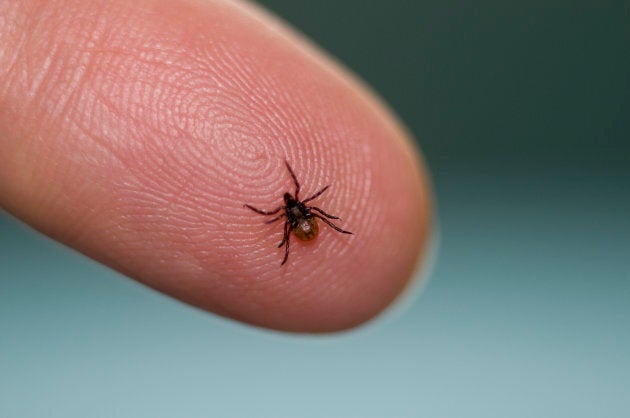
Summer is a short season in Canada, so it's natural to want to get outside in the warm sunshine as much as possible.
However, reported Lyme disease cases in Canada are increasing — from 144 in 2009 to 992 in 2016 — leaving parents understandably worried.
"We see a higher occurrence of Lyme disease in kids aged five to nine years old, most likely because they spend greater amounts of time playing outdoors," Dr. Robbin Lindsay, a research scientist with the Public Health Agency of Canada (PHAC) in Winnipeg, told HuffPost Canada.
Here's what you need to know to keep your kids safe:
1. They lurk in wooded areas, bushes, and tall grass
"Ticks have a limited capacity for horizontal movement; they can't fly or jump," Lindsay explained. "They spend most of their time waiting for a host to brush against them so they can climb aboard to feed."
These tiny arachnids lurk in wooded areas, bushes or tall grass and are generally found on mice, birds, small mammals and white-tailed deer. Once they've attached to a host, they will feed for three to five days.

The size, colour and appearance of a tick varies, so it's wise to review these excellent photos of what ticks can look like along with details of where in Canada these ticks are most prevalent. Ticks aren't limited to only these areas though, and can also be found in the U.S. and Europe.
2. The best offence is a good defence
Only about 20 per cent of the blacklegged, or deer tick, population carries Lyme disease, but ticks (of various species) can also carry other diseases and infections, so bite prevention or early detection are important.
A strong defence includes wearing light-coloured clothing (so ticks are easily visible) that covers as much skin as possible, including head, neck and feet. Shirts should be tucked into pants and pant legs tucked into socks inside closed-toed footwear.

Bug sprays containing 20 to 30 per cent DEET (less than 10 per cent for kids under the age of 12) or Icaridin should also be used and reapplied according to package instructions. Remaining on cleared paths or walkways limits the chance of brushing against a waiting tick.
3. Check bodies, toys, clothes, and pets after being outside
Even if bug spray and long clothing are used, full body checks for ticks should be conducted daily after time outdoors. Tick bites don't usually hurt, so look behind knees, between legs, around the waist, in the navel, on the scalp and hair, on feet, between toes and under arms.
Shower as soon as possible after completing outdoor activities and put clothing worn outdoors immediately in the dryer on high heat for at least 10 minutes to kill any undiscovered ticks. Check toys, food containers, bags or backpacks and pets that have been outdoors before bringing them inside.

Keep lawns mowed short, situate children's outdoor play structures away from wooded areas and get rid of dead leaves, brush and weeds as much as possible. Ensure field animals are kept out of your yard with fences and seal small openings. Finally, give pets that go outside a tick treatment recommended by your vet to prevent them from bringing ticks into your home.
4. If you find a tick, remove it carefully
"Removing ticks within 24 hours of them attaching can significantly decrease the odds of infection," Lindsay said.
Use fine-tipped tweezers as close to the surface of the skin as possible to pull the tick straight out from the skin without squishing or twisting the tick. If the mouth or head stays in the skin and can't be easily removed with clean tweezers, PHAC recommends leaving it there and letting the skin heal after cleaning the area and your hands with an iodine scrub, rubbing alcohol or soap and water.

Save the tick and send it for testing according to these instructions.
5. Know the symptoms of Lyme disease
Lyme disease symptoms can differ from person to person, but often resemble a mild flu and usually begin three to 30 days after an infected tick bite. See a doctor as soon as possible if any of these symptoms occur:
- a rash or rashes, sometimes in a bulls-eye shape
- fever
- headache
- chills
- aches in muscles and joints
- lymph node swelling
- fatigue
If left untreated, symptoms can worsen and may last for months or years at varying levels of severity, including death in rare cases, according to PHAC.
"Children often don't have the advanced communication skills to verbalize symptoms," Lindsay said, making prevention and inspection critical steps in ensuring kids don't suffer long-term with Lyme or other tick-spread diseases and infections.
Also on HuffPost: